The Spiral of Wrath: The crash of Armavia flight 967
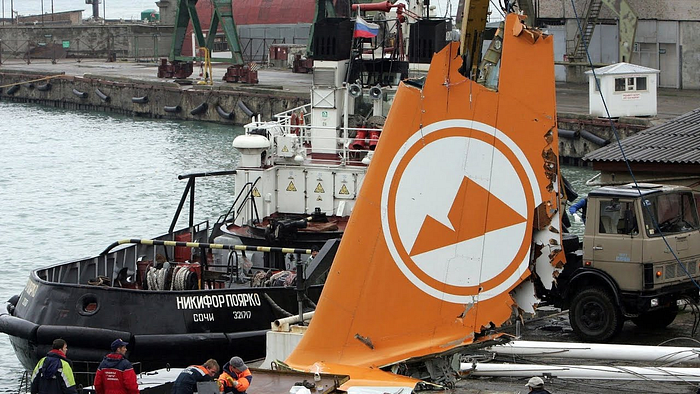
On the 3rd of May 2006, an Armenian Airbus A320 on approach to the Russian resort city of Sochi slammed into the Black Sea amid darkness and fog, killing all 113 passengers and crew. The worst disaster in the history of Armenian aviation unfolded shockingly fast. Just 83 seconds before impact, Armavia flight 967 was aligned with the runway and glideslope, fully configured, with landing clearance in hand — only for events to go suddenly awry, collapsing like a house of cards at the slightest tremor. That fateful jolt triggered a rapid sequence of events that left the captain helpless and confused, unable to comprehend what had gone wrong, even as he flew his plane and its passengers into the water, unaware that he had doomed them all.
The conditions for this meltdown in the cockpit were not created during the final minute of the flight. The full story of the events that night showed that the stage was set by systemic factors such as inadequate training, conflicting air traffic control procedures, and fatigue, as well as hazardous workplace attitudes adopted by the crew, whose words and actions became increasingly choleric as they escalated an imaginary fight with the Sochi approach controller. Descending into a fog of suspicion, they allowed stress to build until finally they snapped, precipitating a loss of situational awareness from which they never recovered. By utilizing a moment-by-moment analysis of how the pilots lost the plot, it becomes possible to understand the seemingly inexplicable loss of this perfectly functional aircraft, and to illustrate how the human mind is the most imperfect system aboard an airplane.
◊◊◊
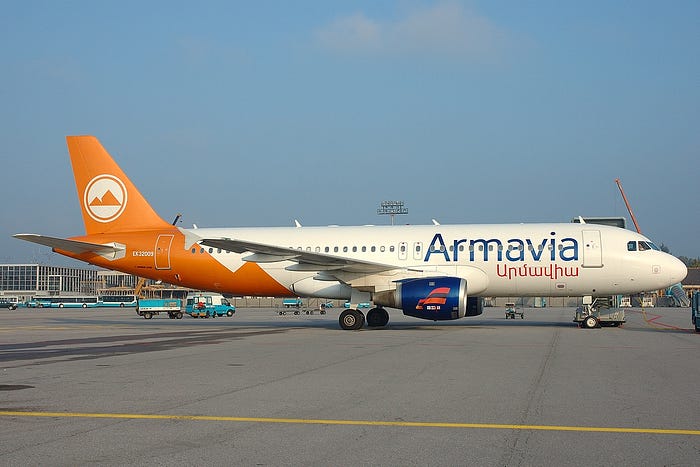
Since its independence in 1991, the Caucasus nation of Armenia has had several different flag carriers that have temporarily borne the country’s tricolor before ceasing operations. One of these was Armavia, which began service in the early 2000s and was notable in part for its decision to become the first operator of the Russian-built Sukhoi Superjet 100 in 2011. Unfortunately, costs associated with the new aircraft type and an economic downturn bankrupted the company by October 2013.
Throughout the airline’s existence, the Airbus A320 and its smaller cousin the A319 formed the core of Armavia’s fleet. The A320 family is the second most popular passenger jet model line after the Boeing 737, and there was nothing particularly extraordinary about the aircraft themselves or the manner in which Armavia operated them, which was typical for the flag carrier of a small country with a single international hub.
Among the destinations served by Armavia was the Russian Black Sea port of Sochi, sandwiched on a narrow coastline at the foot of the Caucasus Mountains. Famed for its spectacular scenery and pleasant weather, Sochi became a popular vacation destination under the Soviet Union and has remained one ever since. Vladimir Putin owns property in the mountains nearby, and the city was the centerpiece of his attempt to present a modernized Russia to the world during the 2014 Winter Olympics.
Some of Sochi’s most important landmarks, including the Olympic stadiums and the city’s main airport, aren’t actually in Sochi, but rather in Adler, about 20 kilometers to the south and separated from Sochi proper by a stretch of steep, rocky coast.
Sochi International Airport lies on the narrow flood plain of the Mzymta River where it comes tumbling down from the mountains, whose proximity renders both of the airport’s runways unidirectional. All approaches are required to be performed from the seaward side, while all takeoffs must be performed out to sea, regardless of wind; operations to or from the airport’s inland side are impossible.
Armavia operated several flights between Yerevan, the capital of Armenia, and Sochi International Airport, including a red-eye designated flight 967, with a scheduled departure shortly before 01:00 in the morning local time. The normal flight time was about an hour.
On the 3rd of May 2006, a total of 105 passengers were booked on the midnight flight, along with eight crewmembers, consisting of two pilots, five flight attendants, and a maintenance engineer.
The pilot in command was 40-year-old Captain Grigor Grigoryan, who had learned to fly in the Soviet Union, starting (as many eastern bloc pilots still do) with the Antonov An-2 biplane. He later flew Yak-40s for Armenian Airlines and Ararat Avia before joining Armavia as an A320 pilot in 2004.
The second-in-command was 29-year-old First Officer Arman Davtyan, who received his initial flight training in Russia in the late 1990s and flew the Tupolev Tu-154 for the Sochi-based Chernomor Avia and later Armenian Airlines, the original flag carrier of Armenia, until its bankruptcy in 2004. He subsequently joined Armavia as an ATR 42 copilot before upgrading to an A320 first officer later that same year.

Prior to departure, the flight crew received the dispatch paperwork, including weather reports for their destination. At that time, Sochi was reporting 2,700 meters visibility in light rain showers and mist, with a cloud ceiling at 1,200 meters. However, the forecast indicated that by flight 967’s estimated time of arrival, the cloud ceiling would reduce to 210 meters, with intermittent fog restricting visibility to 800 meters laterally and 60 meters vertically.
This weather was not so poor as to preclude departure, but the conditions were sufficiently marginal that Captain Girgoryan decided to take enough fuel not only to fly to their alternate airport in Rostov-on-Don, but enough to turn around and fly all the way back to Yerevan as well.
After uplifting the requested fuel and performing the final checks, flight 967 took off from Yerevan Zvartnots Airport at 00:47 and climbed out to the north. Twelve minutes after takeoff, the crew contacted the Tbilisi, Georgia area control center, which authorized them to climb to their cruising altitude of 34,000 feet.
During the climb, the Tbilisi controller relayed the latest weather observations from Sochi Airport, which was now reporting 2,000 meters visibility and a 170-meter cloud base. This drew the flight crew’s attention right away, because the minimum visibility for runway 06 at Sochi was 2,500 meters with a minimum cloud base of 170 meters. Runway 02, which lacked an instrument landing system, had even higher minimums — 3,000 meters laterally and 220 meters vertically. If the present conditions prevailed at the time of their arrival, they would be unable to land.
Six minutes later, now level at 34,000 feet, the crew pre-emptively contacted the Sochi approach controller to hear the latest weather report directly from its source. At most major airports this would be accomplished by tuning into the Automated Terminal Information Service, or ATIS broadcast, but Sochi lacked such a system.
In response to the pilots’ inquiry, the controller transmitted, “RNV 967, well, now the weather is below minima here; that is, on runway 06 the cloud ceiling [is] at 170 meters, visibility 2,000, and the minima [are] 170 by 2,500. And on runway 02 the cloud ceiling is 170 meters, visibility 2,000. 220 is required there.”
“Well, I’ve got fuel, yes, for an hour of flight,” the crew replied. “Is 2,500 expected within an hour?” The response must not have been to their liking because a minute later they repeated, “Clarify further. Within an hour, if there is 2,500, then we will hold and land.”
With significantly more fuel on board than was required for the journey, the flight crew was willing to take their chances by holding over the airport and waiting for conditions to improve above minima, but only if the forecast indicated a generally improving trend. Otherwise, it would be better not to bother.
It took some time for the controller to extract this information from the meteorologist, but at 01:16 Sochi approach reported, “RNV 967, so the forecast for two hours [is] 150 by 1,500.”
These forecast conditions — a 150-meter cloud ceiling and 1,500 meters visibility — were significantly worse than the current conditions and far below the landing minima. Within seven seconds of this report, the crew of flight 967 informed Tbilisi that they intended to turn around and return to Armenia. Tbilisi granted clearance for the turnback, and shortly thereafter, the Sochi approach controller asked, “Say your decision, RNV 967.”
“Yes, what decision, we’re returning to Yerevan,” Captain Grigoryan crossly replied.
Note: Quotations from the flight are derived from two different sources: the BEA translation of the Russian accident report, and an independent translation of diagrams contained in the Russian report. Internal cockpit conversations were mostly in Armenian, which were then translated into Russian, then into English, and not always very competently. As a Russian speaker, I wanted to go and translate these lines from Russian myself, but I was unable to locate the original Russian report. In general I have used the BEA translations as the quality was marginally better, but the independent translation is more complete. In some cases I have made minor modifications to the translations after recognizing patterns in the English text that are associated with common Russian -> English translation errors.
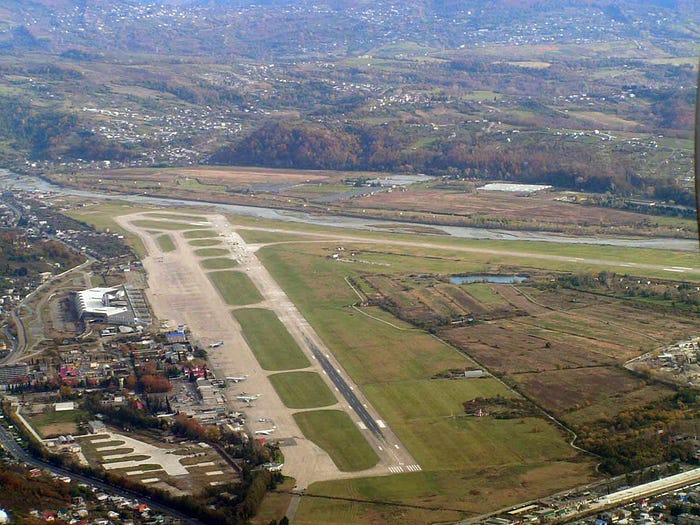
Resigned to the belief that they would be unable to land, Captain Grigoryan and First Officer Davtyan turned their plane around and began heading back across Georgia. This story could have ended there. But in a twist of fate, it didn’t.
What the controller had failed to mention was that the forecast of “150 by 1,500” was intermittent. In between periods of fog, better visibility could and would be encountered throughout the next two hours, a fact that likely would have altered Captain Grigoryan’s decision had he known about it.
Instead, ten minutes after turning around, the crew decided to try one last trick. At 01:26, they again asked the Sochi approach controller for the current weather, but this time they added, ominously, that there were “deputies on board.”
In Russia, “deputies” are members of a legislative body, such as a regional assembly or the State Duma, and although it’s not clear which type of deputy the pilots meant, it also didn’t matter, because there were no legislators of any sort on board the airplane. But by implying that there were, the crew hoped to intimidate the controller into providing a more optimistic weather report, an intention that they confirmed during a conversation with a flight attendant 17 minutes later.* Needless to say, having deputies on board one’s aircraft does not magically cause the weather to improve, so the lie was at best useless, and at worst irresponsible, since it might have masked an intention to land regardless of whether the conditions were above minima or not, as long as the compliance of air traffic control could be obtained. Unfortunately, this is a time-worn tactic in the former Soviet Union, largely because the impunity enjoyed by elected officials is sufficiently intimidating that it sometimes works.
*Note: This conversation was mentioned in the report but was not in the transcript.
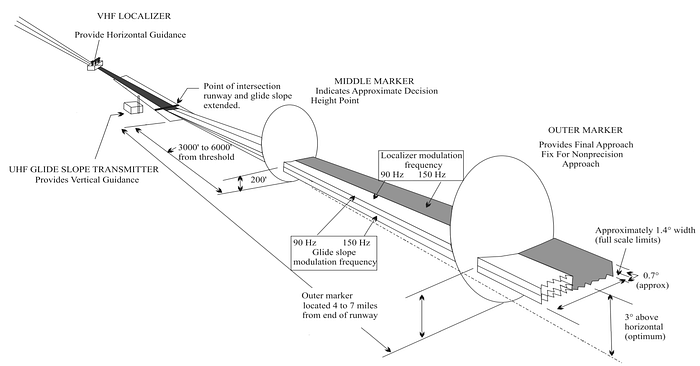
Minutes later, at 01:30, the controller returned with the latest weather observation from the meteorologist. “Armavia 967, visibility 3,600, cloud ceiling 170, for 30 minutes. The weather is around the limit, but okay so far.”
These conditions were just above the minima, but whether that represented an actual improvement or simply the effects of the pilots’ “encouragement” is not stated in the final report.
Nevertheless, pleased that their scheme had apparently worked, Captain Grigoryan elected to turn around again and proceed to Sochi after all. After receiving clearance from Tbilisi, the crew reported to the Sochi controller, “967, we are coming back.”
By 01:40, flight 967 had turned around once again and was heading northwest toward Sochi. In the cockpit, the pilots prepared for an anticipated ILS approach to runway 06. Like any ILS approach, this involved a localizer signal to align with the runway, and a glideslope signal to delineate the glidepath to the runway, usually at a 3-degree angle, although Sochi’s is calibrated to slightly less than that. Both signals can be automatically tracked by the A320’s autopilot when set to Approach mode.
During this time, the crew also briefed the missed approach procedure, which called for a right turn to heading 240 and a climb to 600 meters (2,100 feet),* with a maximum airspeed of 200 knots and a bank angle of 20 degrees. They also briefed the similar missed approach procedure for runway 02, just in case. Both procedures required an immediate course reversal due to the presence of mountains immediately beyond the airport.
*Note: In Russia, altitude clearances are given in meters rather than feet.
*Note 2: 600 meters in fact equals slightly less than 2,000 feet. However, throughout the report, and in the pilots’ conversations, the missed approach altitude is specified interchangeably as 600 meters and 2,100 feet. I was not able to resolve this discrepancy.
Minutes later, at 01:44, Captain Grigoryan made several worrying comments, in which he expressed a strong desire to avoid a diversion. To that end, both pilots articulated a plan to keep their communication with Sochi Approach to a minimum, in order to deprive the controller of opportunities to report adverse conditions.
Both of these actions indicated that the flight crew was mentally committed to landing at Sochi and was prepared to take potentially unreasonable steps to achieve that goal. Having already chosen to divert then changed their minds, they may have felt increased psychological pressure to avoid making such a decision again, which would upset the passengers, and potentially the airline. It was at this point that the first indications of an adversarial relationship with the Sochi controllers began to develop. In their conversations, the pilots characterized their discussions with Sochi Approach as a “negotiation” rather than a mere exchange of information, as though the reported weather conditions were decided by the controller based on his mood, and not by mother nature.
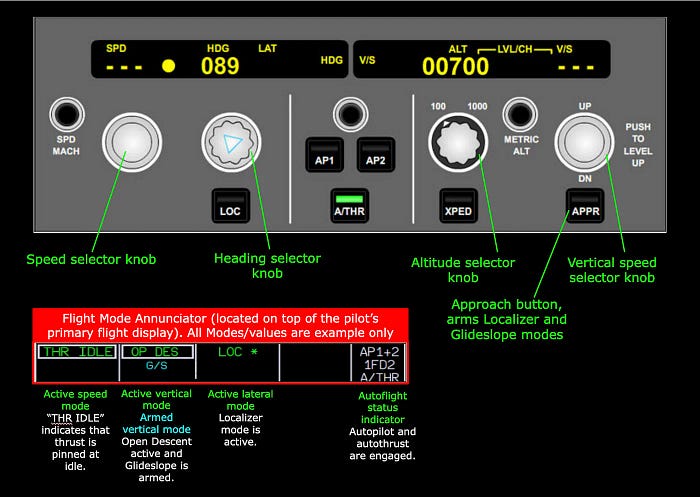
Moving into the next phase of the flight, Captain Grigoryan led the descent and approach briefing, and at 01:52 they were cleared by Rostov area control to begin a descent to 6,700 meters (22,000 feet).
At this point it’s worth briefly reviewing how the Airbus autoflight system works. The autoflight system, consisting of the autopilot and the autothrust, contains numerous operating modes that broadly fall into two categories, called “managed” and “selected.” When a “selected” mode is engaged, the autoflight systems will maintain an airspeed, vertical speed, and/or heading selected by the flight crew using the Flight Control Unit (FCU), shown above. The pilot enters a desired value by rotating the associated knob, then pulls the knob outward to engage the corresponding selected mode. For example, using the vertical speed knob to select a descent rate of 1,000 feet per minute and then pulling the knob outward will engage “Vertical Speed” mode, and the autopilot will modify the pitch of the airplane to achieve this descent rate.
In contrast, in a “managed” mode the autopilot and autothrust take their cues from the flight plan programmed into the flight management guidance computer, or FMGC. Prior to departure, the pilots normally enter the waypoints and/or altitudes that they will use during the flight, and the autoflight systems can then make a complex series of inputs in order to follow this track, or to follow only the lateral or vertical component. A managed mode can be engaged by pressing the corresponding knob inward. For example, pressing the heading knob inward will engage NAV mode, which will cause the autopilot to navigate between the waypoints programmed in the FMGC. (Airbus pilots, feel free to correct, I wrote this part from memory at the last second.)
Returning to the moment of the descent clearance, the pilots immediately selected a new target altitude of 6,700 meters, and then pressed the vertical speed knob inward to engage the autopilot’s managed “Descent” mode. In this mode, the autopilot descends according to the vertical profile calculated by the FMGC, taking into account the expected number of track miles remaining, until reaching the selected altitude. However, Captain Grigoryan appeared dissatisfied with the rate of descent that resulted from this mode selection, prompting him to harshly exclaim, “This one here is also crazy, she’s not descending, brother, I don’t understand, you descend, [expletive] your mother.”
Grigoryan then reached over and pulled the altitude knob outward to engage “Open Descent” mode, in which the autothrust locks engine power at idle while the autopilot controls pitch to achieve the selected airspeed. With the engines at idle, a nose down pitch will be required to maintain airspeed, resulting in a potentially quite rapid descent, which was exactly what Captain Grigoryan wanted. As a result of this selection, their rate of descent increased from 5 m/s (1,000 ft/min) to 12 m/s (2,400 ft/min).
In response, First Officer Davtyan commented, “[Expletive] it, who operates such flights with the jitters and not enough sleep?” This line not only indicated that the crew were experiencing fatigue, but also might have hinted at some level of frustration with the airline for scheduling a flight to Sochi at one o’clock in the morning.
Captain Grigoryan, however, was still focused on the autopilot. “This one doesn’t want to keep in the MANAGE, does it brother,” he said, referring to the “managed” Descent mode. “Now have a look here,” he added, “It doesn’t want to, you can’t make it.”
First Officer Davtyan then suggested that they switch to the aircraft’s second, redundant autopilot because that one was “better in Descent [mode].” This makes no sense from a technical perspective, but the pilots evidently believed that it would make some difference. According to the French BEA, the tepid descent rate in Descent mode was probably because the FMGC flight plan included a waypoint called LAMET that was not part of the runway 06 approach procedure and greatly increased the number of track miles. At some point after this exchange Davtyan suggested removing LAMET from the flight plan to correct the problem, but Grigoryan refused, believing that ATC might send them there later. The time stamp of this conversation is not specified in the official reports.
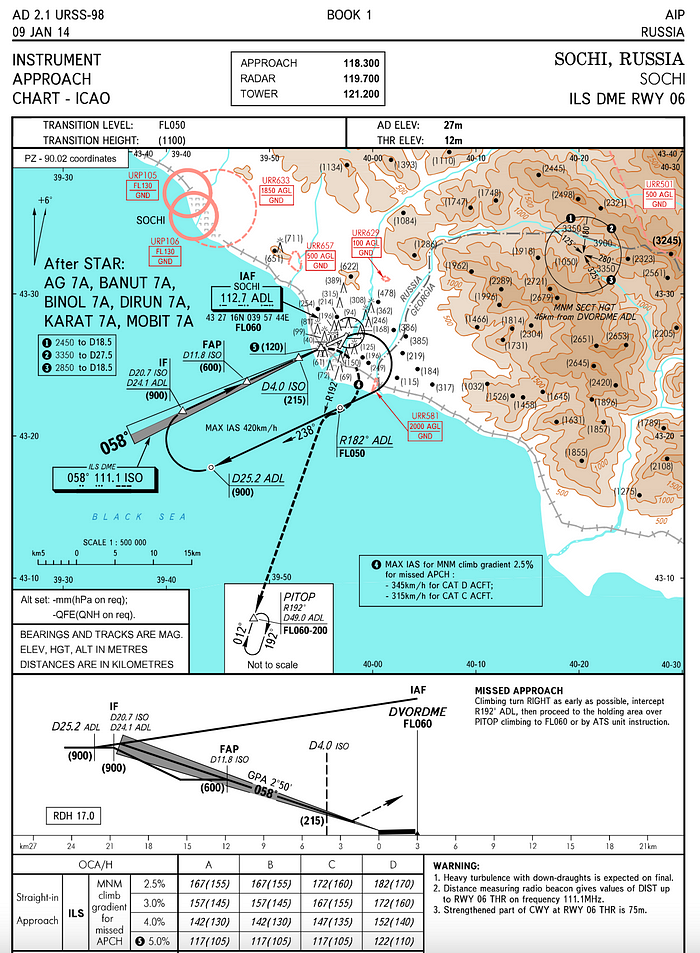
Now established in a descent, at 01:58 the crew received clearance from Rostov center to descend to 3,600 meters (11,900 ft), and at 02:00 they were instructed to contact Sochi approach for further instructions. After establishing contact, the Sochi approach controller informed them at 02:01 that the current visibility was 4 kilometers with the cloud base at 180 meters amid light rain. These conditions remained above the approach minimums, but not by very much.
In response to the report, Captain Grigoryan decided to begin the approach. The controller warned them to increase their rate of descent or they would overshoot the ILS intercept point, then handed them off to the next control position, known as “Sochi krug.” This position doesn’t have a Western equivalent that immediately jumps to mind, but it means “holding,” and the English versions of the Sochi approach plates call it “Sochi radar,” which is also the term used in some countries for the approach controller position. The final report doesn’t specify how many controllers were on duty in Sochi at 2 o’clock in the morning, but some statements in the text imply that the approach and radar positions may have been manned by the same person, since flight 967 was the only aircraft in the area. The flight crew would have been well aware of this, but I was unable to confirm whether it was the case.
At 02:03, the radar controller cleared flight 967 to descend to 600 meters (2,100 feet) and begin the right turn onto the final approach heading of 060, positioning the aircraft to intercept the ILS. An altitude of 600 meters was required in order to intercept the glideslope at the designated ILS intercept point; if they were above this altitude at the intercept point, then they would have to play catch up to intercept the glideslope from above, which is considerably more difficult.
Seconds later, Captain Grigoryan initiated the right turn using the autopilot’s selected Heading mode, which has a maximum bank angle of 24 degrees. Because of the sustained descent without the landing gear, flaps, or speed brakes extended, their airspeed had by now ballooned to 280 knots, which was too fast for this stage of the approach. At this speed, the bank angle limit in Heading mode was too low to accomplish the turn without overshooting the final approach course to the left. To make matters worse, they were still descending through 10,000 feet, about 3,000 feet above the expected altitude at this point in the approach, as a result of which it was difficult to slow down without making their altitude problem worse.
As they began the turn, flight 967 flew into clouds and precipitation, prompting Captain Grigoryan to order the landing lights on. “Is this snow or rain? What the ****!” First Officer Davtyan exclaimed.
Realizing that they were overshooting, Grigoryan switched the autopilot’s pitch mode to “Vertical Speed” and commanded an increased descent rate of about 2,500 feet per minute. Moments later, Grigoryan disengaged the autopilot for 14 seconds, presumably to make a tighter turn and reduce the severity of the overshoot, although he didn’t tell First Officer Davtyan what he was doing or why. After re-engaging the autopilot, he set the selected heading to 090, or due east, in order to correct their course to the right. Shortly afterward, the radar controller called and said, “Armavia 967, you’re left of the landing course, you can turn onto heading 090 to intercept.” The crew tersely replied that they had already done so. Around this time the report states that they cursed the controller with inflammatory language and continued to do so for the next three minutes, in between checklist items, but the contents of these conversations were not published.
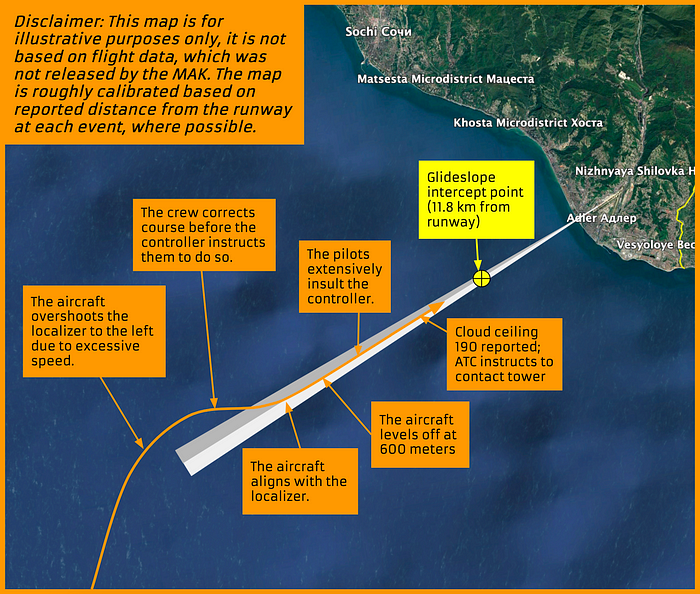
At 02:06, after reporting that they were approaching 600 meters, Grigoryan engaged the autopilot’s Approach mode to prepare to intercept the instrument landing system. But just one minute later, the radar controller reported, “Armavia 967, we’ve been given cloud base 160 meters, visibility 4,000. Proceed at 600 meters without descent.”
With the cloud base now at 160 meters, below the minimum of 170, the tower would not authorize the flight to land, preventing a descent below the ILS intercept height of 600 meters. The flight crew responded angrily to this news, and the captain pejoratively referred to the control tower as a “madhouse” or “insane asylum.”
Moments later, the aircraft approached the localizer, and the localizer capture mode engaged in the autopilot’s lateral channel, causing the autopilot to turn left and align with the runway. Level at 600 meters and on course with no lateral deviation, they were finally in position to land, if the controller would let them.
With the approach checklist complete, the pilots had to decide whether they should complete the landing checklist despite the lack of landing clearance so far. “Shall we say that it suits us?” First Officer Davtyan asked. “Landing, Grisha?”*
“How [does it] suit us? It is below the minimum,” Captain Grigoryan replied.
“[By] 10 meters,” said Davtyan. It seemed that the first officer preferred to continue the approach.
*Note: Grisha is the familiar form of Grigor, the captain’s first name.
In the end, Grigoryan decided to hedge his bets and prepare for landing in the event that conditions improved. “Let’s deploy flaps 1, **** him,” he said, apparently throwing another insult in the controller’s direction. It’s possible that Grigoryan viewed deploying the flaps as an act of rebellion.
“Speed check flaps 1,” Davtyan called out. “Clear status?”
Grigoryan checked that they were below the maximum speed for flaps 1, which they were. “Clear,” he announced, and Davtyan complied. Seconds after that he commanded flaps 2 and reduced the selected airspeed to 133 knots in preparation for selecting flaps 3 and finally flaps FULL.
At 02:09, the pilots’ bet paid off, when the radar controller called and said, “RNV 967, contact tower, 4,000 by 190.” With the visibility at 4,000 meters and the cloud ceiling back above the minimum of 170, they would certainly be cleared to land.
Captain Grigoryan immediately ordered the landing gear down, while First Officer Davtyan contacted Sochi tower to report that they were on course and ready to land. In response, Sochi tower instructed them to report intercepting the glideslope.
In the cockpit, Grigoryan continued to rant against the Sochi controllers. “Have you simply understood him?” he said. “We have come to landing approach, have lost time, he has given us once again 190. He tries to squirm out of his failure.”
“But I don’t understand, what will he gain here?” Davtyan asked.
“Sometimes you win…” Grigoryan trailed off without saying ‘sometimes you lose.’ “What bullshit, [unintelligible] at times 190, at times 160, understand what I say,” he added.
“He only [wants] us to get a coronary,” Davtyan replied.
“Now it is below the minimum,” said Grigoryan. “A word, something will happen and 150 will be measured.”
Assuming that the approach and radar controllers were in fact the same person, which the final report implies, then this conversation appears to be a continuation of the pilots’ previous suspicions about the controller on duty. The pilots believed that the controller was trying to give them a heart attack with rapidly changing weather reports and wanted to figure out why. The obvious answer — that waves of fog were moving over the airport, causing fluctuations in the cloud ceiling — was seemingly not up for consideration.

At 02:10, the tower controller (who appears to be a different person) informed the crew that they were 13 kilometers from touchdown and approaching the glideslope intercept point, and 30 seconds later the autopilot successfully captured the glideslope and began tracking it downward, with their airspeed approaching the selected 133 knots. “Armavia 967, on glideslope, landing gear extended, ready for landing,” Davtyan transmitted.
“Armavia 967, distance 10, on course, visibility 4,000, fog, compact clouds 190 meters, cleared to land,” the tower replied.
Davtyan acknowledged the clearance and Grigoryan ordered flaps 3. Davtyan selected flaps 3 but warned, “Give a little bit, sitting almost on VLS [lowest selectable speed].” In response, Grigoryan increased the selected airspeed to 137 knots, then ordered flaps FULL. The flight crew then ran through the landing checklist, checking that they had informed the cabin crew, set the autothrust, deployed the landing gear, and other final items.
But just as they were finishing the checklist, the tower controller butted in with a bombshell: “RNV 967, stop descent, cloud 100 meters, turn right, climb 600.”
This was arguably the pivotal moment in the story of flight 967, necessitating some context and analysis.
When the conditions fall below the minima for landing, there is a responsibility to break off the approach, because a safe landing is unlikely. In most of the world, this responsibility formally lies with the captain of the aircraft. But Russia is one of a small handful of countries where air traffic controllers are invested with this authority instead. In Russia, a controller is obligated to instruct an aircraft to go around if the conditions are below landing minima, which is generally not the case in the rest of the world, where controllers simply provide the weather reports and the captain is obligated to call for a go-around if the conditions are unsuitable. Because Russian regulations differ on this point relative to international standards, Russian controllers are technically only allowed to order domestic flights to go around due to visibility, whereas international flights operate under International Civil Aviation Organization (ICAO) rules that place this responsibility on the captain. Nevertheless, the tower controller at Sochi that night ordered flight 967 to stop its approach anyway.
This unexpected order immediately threw the cockpit into chaos. They had already been cleared to land, the last reported conditions were above minima, and they had not yet reached their decision height, so the pilots would not have expected to go around at this point in the approach. Furthermore, the controller didn’t use the words “go around,” but rather gave specific piloting instructions — “turn right, climb 600 [meters].” This type of instruction is not unheard of in the former Soviet Union, but even in Russia, the standard phraseology should be “flight 967, go around.” The right turn and climb to 600 meters are implied in this instruction because they’re part of the published go-around procedure, which every flight crew reviews before starting the approach. The absence of a standard “go around” instruction might have had significant influence on the events that followed.
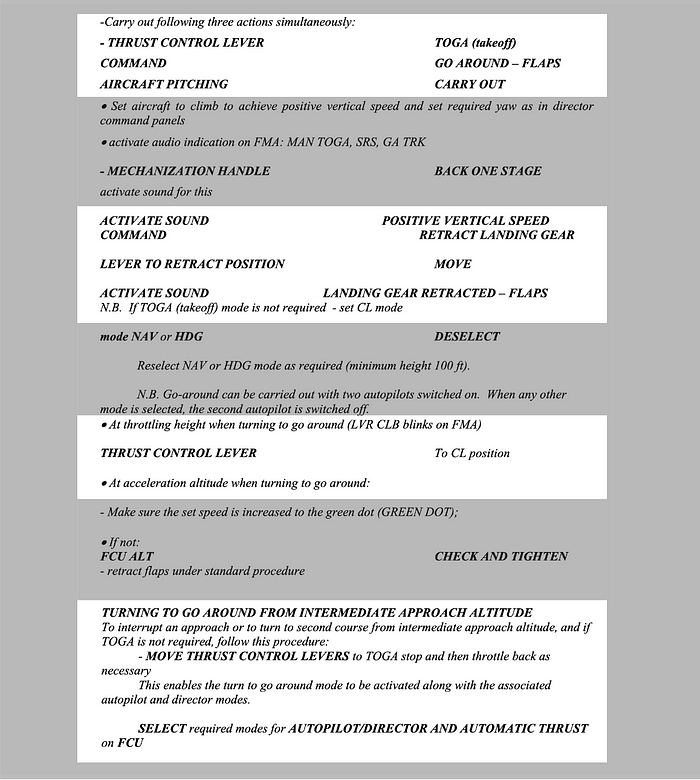
At that moment, the aircraft was 7 kilometers from the runway, descending through 390 meters (1,280 ft), at an airspeed of 139 knots with the thrust levers in the “climb” detent. On the Airbus A320, the pilots don’t normally set the specific thrust output manually; instead, the autothrust system determines how much thrust is needed to maintain the selected speed and/or flight path. The pilots can also determine the maximum power that the autothrust can command by setting the thrust levers to one of several general detents, such as cruise (CR), climb (CL), or takeoff/go-around (TOGA). That means that when the thrust levers are set to “climb,” the autothrust might apply maximum climb power if necessary, but will keep a lower power setting if not. The exception to this rule is TOGA, where you get the same (very high) amount of power no matter what. The position of the levers themselves doesn’t change during flight except when a new operating regime is commanded.
During a go-around, the standard procedure in essentially any modern transport aircraft is to set the thrust levers to TOGA to ensure maximum power, pitch up to a memorized value (often 15 degrees), retract the flaps (to position 3 in the A320’s case), and finally retract the landing gear. On the A320, moving the thrust levers to TOGA in the air causes the autoflight systems to enter go-around mode, which will compel the autopilot and autothrust to achieve the go-around speed and pitch and then fly to the pre-selected go-around altitude entered in the Flight Control Unit (FCU). This altitude is normally pre-set by the crew during the intermediate approach phase in order to make a go-around simpler. Setting the go-around altitude in the altitude window on the FCU while in “Approach” mode won’t do anything because in that mode the autopilot is taking its vertical guidance from the glideslope and not from the FCU selected altitude, but as soon as “go-around” mode is engaged, this pre-set altitude becomes active.
Notably, Airbus procedures state that in the event of a go-around earlier in the approach, when the go-around altitude is close to the actual altitude, full TOGA power might be unnecessary. In that case, the operations manual recommends that the crew advance the thrust levers to TOGA to engage go-around mode, then immediately move the thrust levers back to an appropriate power setting. This would arguably have been applicable to flight 967 because the aircraft was only 210 meters (690 feet) below the go-around altitude when the controller ordered the missed approach.
But what actually happened aboard flight 967 didn’t resemble either of these procedures. Instead of advancing the thrust levers and engaging go-around mode, Captain Grigoryan first pressed the “push to level off” button, which does exactly what you think. This caused the autopilot’s pitch channel to stop tracking the glideslope and switch to Vertical Speed mode with a pre-programmed vertical speed of zero. The lateral channel simultaneously changed to Heading mode with the aircraft’s current heading selected. In response, Captain Grigoryan immediately used the heading knob on the FCU to select a southeasterly heading of 172 degrees in order to initiate a right turn, as commanded by both the air traffic controller and the go-around procedure for runway 06 at Sochi.
Bizarrely, however, he also began to make inputs on the rudder pedals, which is unnecessary in the A320. On light aircraft and some airliners, a turn must be “coordinated” through the use of the rudder to ensure that the nose remains pointed in the direction of the turn. But on the A320, turn coordination is automatic, and manual rudder inputs are not necessary in normal flight. The fact that he was attempting to move the rudder suggests that Grigoryan was already beginning to lose situational awareness.
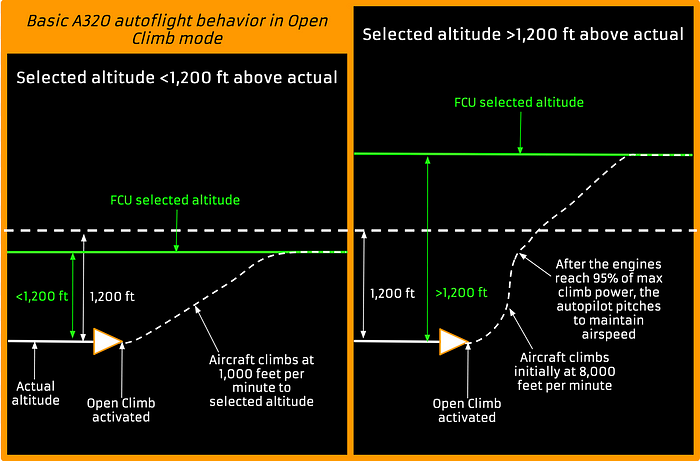
As Grigoryan began the turn, the tower controller repeated the instructions and told the crew to contact the radar controller, which First Officer Davtyan acknowledged. As he did so, Grigoryan, again without saying anything, increased the selected altitude in the FCU from 600 meters (2,100 ft) to 975 meters (3,200 ft) and pulled the altitude selector knob outward to engage “Open Climb” mode. This causes the autopilot to pitch up to climb at a pre-programmed vertical speed until reaching the FCU selected altitude, while the autothrust increases engine power to maintain the selected airspeed during the climb. However, the exact implementation of open climb depends on whether the difference between the FCU selected altitude and the actual altitude is less than or greater than 1,200 feet.
If the level change is less than 1,200 feet, then the autopilot will pitch to maintain a climb rate of 1,000 feet per minute while the autothrust maintains the selected airspeed. But if the level change is more than 1,200 feet, then the autopilot will initially pitch to achieve a climb rate of 8,000 feet per minute, while the autothrust initially increases power toward max climb, or as necessary to maintain the selected airspeed. Then, when the thrust output reaches 95% of max climb, the autopilot will start pitching to maintain the selected airspeed while the autothrust maintains steady climb power. This tends to a result in a steep initial climb followed by a mellower phase. It should also be noted that when this implementation of open climb occurs less than 30 seconds after the use of the “push to level off” button, the autopilot is allowed to induce a vertical acceleration of up to 1.3 G, instead of the normal maximum of 1.15 G, resulting in a more abrupt pull-up. The logic behind this design is outside the scope of this article.
By selecting an altitude of 975 meters (3,200 ft), which was more than 1,200 feet above their current altitude, Captain Grigoryan triggered this second implementation of open climb. But there was no obvious reason for him to do this, because the go-around altitude was only 600 meters (2,100 ft), and had already been selected. The final report states that investigators were unable to determine why he selected 3,200 feet, but an independent analysis by Ladkin et al. speculates that he might have accidentally turned the knob while attempting to pull it outward to engage open climb. This type of error is known to occur due to the configuration of the A320’s FCU, where parameter selection and mode selection are achieved using different functions of the same knob.
In any case, when open climb mode was engaged, the autopilot pulled the nose up abruptly with a vertical acceleration of 1.27 G, reaching a pitch angle of 21 degrees nose up, in order to begin climbing at 8,000 feet per minute. At the same time, the autothrust attempted to increase power toward max climb, but the response of the engines was too slow to prevent their airspeed from decreasing, triggering an automated low energy warning that called out, “SPEED, SPEED, SPEED” over the cockpit speakers.
This warning was triggered largely because the crew of flight 967 were operating outside the scope of what Airbus intended. Since the aircraft was still in the landing configuration with the landing gear down and the flaps set to FULL, there was so much drag on the airplane that the engine response was not quick enough to prevent a loss of airspeed when the autopilot initiated a rapid climb. Airbus design engineers had never intended for open climb to be used in the landing configuration, because a sudden climb during final approach is by definition a go-around, for which go-around mode should be used instead. Testing after the accident showed that a low energy warning was always generated when open climb was engaged in the high climb rate regime with the aircraft in the landing configuration, but engine thrust always built up fast enough to reverse the loss of airspeed without triggering any of the Airbus’s flight envelope protections, which are designed to prevent an outright loss of control. Furthermore, once 95% of max climb thrust was achieved, the autopilot would start pitching down to rein in the climb rate and maintain the selected airspeed, preventing any further speed decay. As such, this phenomenon was undesirable but not dangerous.
Unfortunately, Captain Grigoryan was not aware of this, and his reaction suggests that he believed his aircraft was in danger. Startled by the steep pitch up, the elevated G-forces, and the unexpected warning, Grigoryan finally advanced the thrust levers to TOGA, engaging go-around mode, then disconnected the autopilot. By that time the autopilot had already begun reducing the high pitch angle, both engines were accelerating toward TOGA, and their airspeed was increasing — in other words, the situation was under control.
With the autopilot disconnected, Grigoryan was now controlling pitch and roll manually, but he was not without guidance. Instead, the flight director overlay on both pilots’ primary displays began indicating the pitch and roll angles required to perform the go-around and achieve the selected heading. In this case the flight director would have suggested a right bank and a nose up pitch of about 8 degrees.
As soon as Grigoryan took control, he pitched down to 4 degrees and partially leveled the wings, causing the aircraft to diverge from the go-around track. However, this did cause the airspeed to increase, which was probably his intention.
At the same time, Grigoryan apparently realized that the go-around altitude was improperly set, as he called out, “600, set the altitude!”
“But what, isn’t it 600?” First Officer Davtyan replied, believing he had already set 600 meters, unaware of Grigoryan’s misinput. Both pilots’ voices appeared highly agitated.
“Set 600!” Grigoryan repeated.
“2,100,” Davtyan acknowledged, converting 600 meters to feet.
When Davtyan selected 600 meters/2,100 ft in the FCU altitude window, the flight director reduced the amount of suggested pitch up, because the selected altitude was now closer to the actual altitude.
Simultaneously, Captain Grigoryan reduced the thrust regime from TOGA back to Climb. This was consistent with the standard go-around procedure, which called for thrust to be reduced to Climb at 1,500 feet above the airport elevation. At this altitude, the flight mode annunciator flashes a small “LVR CLB” (lever climb) indication to remind the pilot to do this, which is probably what prompted Grigoryan’s change of thrust setting. However, he still hadn’t accomplished any of the other required configuration changes for the go-around, since the flaps and landing gear were still fully extended.
Other than this improper configuration, the situation was now fairly stable, belying the utter confusion within. The aircraft was climbing slowly with a comfortable airspeed of 163 knots, the correct altitude and thrust were set, and Grigoryan was banking 20 degrees right, exactly as called for in the Sochi go-around procedure. But that was about to change.
At 02:12:28, the tower controller repeated the instruction to contact the radar controller, which still had not been done. As First Officer Davtyan again acknowledged the instruction, unbeknownst to him Captain Grigoryan started pushing forward on his side stick to lower the nose. There was no real reason to do this; in fact, up until that point the pitch angle had been quite close to the flight director’s suggested pitch angle. Further nose down inputs would cause the aircraft to level off before reaching the go-around altitude, which was certainly not what Grigoryan wanted. And yet, he pushed far enough forward to bring the nose below the horizon and put the aircraft into a descent.
Investigators would later expend considerable energy trying to understand why he did this, but there was likely no single reason. For instance, he might have been affected to some extent by the somatogravic illusion — the sensation of pitching up when one is actually accelerating. Due to the low pitch angle and high power setting, the aircraft was accelerating, and amid the darkness and fog there would have been no outside references. If so, the pitch down inputs might have been an instinctive reaction to a perceived pitch up that didn’t actually exist. Alternatively, another contributing factor might have been the sudden decrease in the pitch attitude commanded by the flight director when the selected altitude was reset back to 600 meters. The appearance of the flight director command bar moving down toward the current pitch indication can subconsciously resemble the opposite motion, i.e. the current pitch indication rising toward the flight director command bar, creating an illusion of nose up movement. When under extreme stress, a pilot could instinctively react by pitching down.
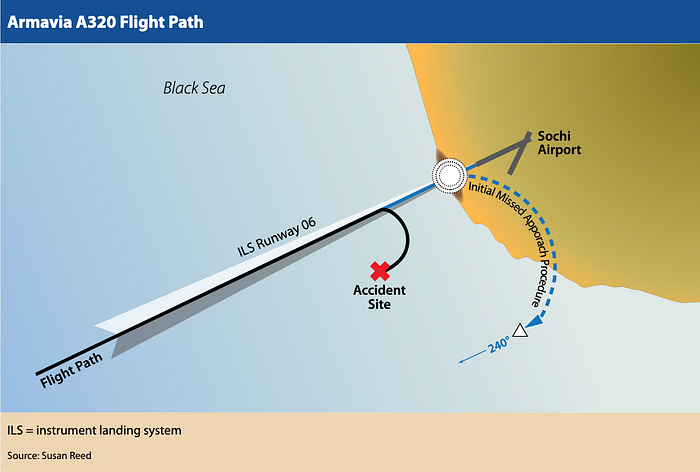
As the pitch down began, First Officer Davtyan started to transmit, “Sochi radar, Armavia 967…” He never finished the statement, which would be the last controllers heard from the aircraft. At that moment their altitude peaked at 510 meters (1,670 ft) before the aircraft began to descend.
One second later, Grigoryan called out, “Flaps!” Most likely he had observed that their airspeed was rapidly approaching the red overspeed bar on his airspeed indicator, which showed that the maximum speed with flaps FULL was 177 knots. First Officer Davtyan immediately set the flaps to position 2, but before they could fully retract, the flap limit speed was exceeded, triggering the master warning light and an aural overspeed alarm, consisting of a continuous repetitive chime. This warning would continue throughout the rest of the flight.
Rolling 33 degrees to the right and pitched five degrees nose down, the aircraft embarked on a tightening spiral as alarms blared in the cockpit. First Officer Davtyan retracted the flaps to position 1, where the maximum speed was 215 knots, but with the engines at climb power and the nose pointed downward, they were accelerating so fast that this failed to silence the overspeed warning, and the flaps moved automatically to the fully retracted position to prevent airframe damage.
At the same time, Captain Grigoryan pushed his side stick even farther forward, causing the nose to drop to -11 degrees. In addition to the factors described previously, this additional nose down input might have been made in reaction to his airspeed indications. When the speed is rising toward the red overspeed bar at the top of the indicator, a pilot’s instinctive reaction when under extreme stress can be to push forward to try to avoid the red zone at the top of the screen, as though the red bar is a real object looming above them. However, pitching down causes the speed to increase further, making the problem worse, which potentially begets further nose-down inputs.
Six seconds after the start of the overspeed warning, at 02:12:47, First Officer Davtyan shouted, “Level off!” Almost simultaneously, the ground proximity warning burst into life, blaring, “PULL UP! PULL UP!” The airplane was banked 39 degrees to the right, with a descent rate of 4,300 feet per minute and increasing. At this rate they would impact the water in less than 20 seconds.
In the background, the voice of the controller droned on: “Armavia 967, Sochi radar, after exit on second circle, take heading 210, take 600 meters and follow 600 meters. Prepare for landing on runway 02. There lower cloud base 460, 360 meters, visibility above 4 kilometers…”
Recognizing that something was horribly wrong, Davtyan grabbed his own side stick and pushed it to the left stop in an attempt to prevent the right bank from escalating, all the while shouting, “Level off! Level off the roll!” Unknowingly, however, he made the problem even worse. Because the side stick was positioned slightly in front of him, his large, hurried leftward force included a “parasitic” forward input that pushed the nose down even further. In violation of standard procedure, he did not call out his takeover of the controls, nor did he press the takeover pushbutton to lock out the other side stick. At the same time, Grigoryan recognized the GPWS alerts and began to pull his sidestick back to raise the nose, but because he and Davtyan were making opposite inputs, the result was no net change in the pitch angle. Furthermore, because the Airbus side sticks are not interconnected, Grigoryan could not feel that Davtyan was making nose down inputs. The simultaneous operation of both sidesticks would normally have generated a “dual input” warning, but this warning had a lower priority than the GPWS and was therefore not annunciated.
Unsure why the airplane wasn’t reacting to his inputs, the panicked Grigoryan shouted, “What’s happening!?
“Grisha brother, the slats! Level off the roll!” Davtyan exclaimed.
In the final seconds, the pilots’ actions became increasingly incoherent. No one reacted properly to the GPWS warnings. Apparently reacting to the ongoing overspeed warning, one of the pilots rapidly moved the thrust levers from Climb back to Idle, then forward to Climb again, causing the autothrust to disengage. The descent rate was almost 6,000 feet per minute, less than 1,000 feet above the water. Someone retracted the slats. Grigoryan continued to make larger and larger rudder inputs. The bank angle decreased to about 6 degrees, and both pilots finally hauled back on their side sticks; the pitch angle increased to -6 degrees, reducing the descent rate slightly, but it was far too late.
At 02:13:03, Armavia flight 967 plowed nose-first into the surface of the Black Sea at a speed of 285 knots. In an instant, 113 lives were snuffed out forever, and a perfectly functional Airbus A320 was reduced to jagged fragments floating on the night-dark water.
◊◊◊
Immediately following the accident, Sochi controllers tried to contact the airplane without success, and within three minutes an emergency had been declared. But due to poor visibility, rescue helicopters were unable to launch, and boats had to be sent to the crash site instead. The scene of the accident was first discovered at 08:08 the following morning, when a boat operated by the Russian Ministry of Emergency Services discovered an oil slick and debris. By 11:30, bodies were being pulled from the water. No survivors were found.
In Armenia, the reaction was one of shock and grief. The crash was by the far the worst air disaster ever to befall the country, before or after independence, and both Armenia and Russia declared periods of national mourning.
News of the crash also quickly reached the Interstate Aviation Committee, or MAK, which was charged with investigating the causes of the accident. The MAK is the primary aviation investigation agency for multiple post-Soviet countries, including both Russia and Armenia, and operates independently of any government.
During the initial phase, investigators focused on the search for the black boxes. With the wreckage lying at a depth of 500 meters, the MAK appears to have been ill-equipped for the complex salvage operation, because the vast majority of the airplane and its occupants were not recovered, except for those items found floating on the surface, including the vertical stabilizer. Finding the black boxes required several weeks of underwater reconnaissance, but the cockpit voice recorder was finally found on May 22nd, and the flight data recorder was found 40 meters away on May 24th.
Utilizing the black box data, the MAK and Airbus conducted a detailed performance study in order to determine whether the airplane responded normally to the commands it was given, which would reveal the presence or absence of any outside factors such as ice, wind shear, or mechanical failure. The analysis found nothing suspicious; as far as anyone could tell, the aircraft performed in accordance with its design specifications and responded as expected to pilot and autopilot inputs throughout the flight. For this reason, their analysis, focused on the actions of the flight crew and the air traffic controller, as will mine.
◊◊◊
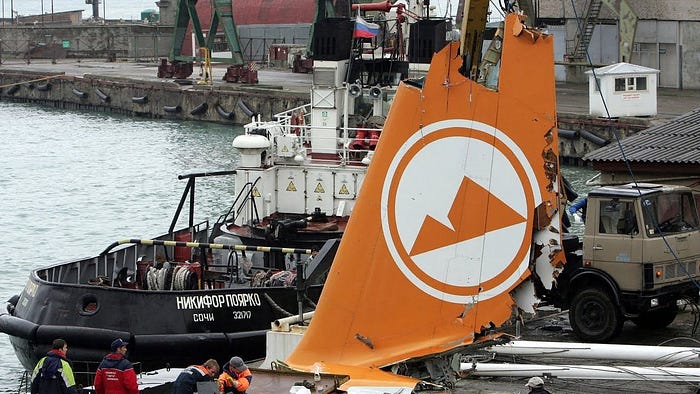
The human causes of the accident were neither straightforward nor obvious, but taken together, it becomes possible to discern how the pilots slowly lost the plot.
Considering the pilot’s backgrounds, they could hardly be called inexperienced, but investigators noted that Armavia’s flight crew training manual had no specific requirements for an “upgrade to captain” training course, nor did Captain Grigoryan ever undergo such a course, which is something I’ve never seen before in all the accidents I’ve researched. Unfortunately, the final report was very light on details and it remains somewhat unclear how Armavia prepared new captains to take up the left seat without a formal upgrade program. If this finding is to be taken at face value, then it’s unlikely that Grigoryan received comprehensive training on topics like leadership and fostering an effective cockpit atmosphere, and he might have been missing more basic skills as well.
Compounding this issue was the specter of fatigue. The flight was scheduled in the early hours of the morning, during the window of circadian low, when the pilots’ bodies expected them to be asleep. First Officer Davtyan commented that he had not gotten enough rest, and if the translation of his statements is accurate, he might have harbored negative feelings toward the airline for scheduling the flight at this hour. It cannot be ruled out that Grigoryan harbored similar sentiments.
As a result of these two factors, an unproductive cockpit atmosphere developed in which the pilots approached the operating environment with an attitude of resentment. This attitude first became apparent after the turnback toward Yerevan, when the pilots decided to intimidate the controller by falsely reporting the presence of deputies on board. Although the turnback and the resulting stress could have been avoided if the controller had properly conveyed the entire forecast, the pilots’ response was inappropriate. The apparent success of their intimidation tactics also led to an expectation that the controller would continue to report favorable weather conditions, which we’ll come back to in a moment.
By this point, the pilots knew they were behind schedule, feared that the weather conditions might be marginal, and distrusted the Sochi controllers. Amid mounting stress and displeasure, the pilots cursed at their own airplane and expressed frustration with its functionality, even though all systems were operating normally. Due to flight planning mistakes, they soon found themselves too high and fast on approach, increasing stress levels even further. Elevated stress can result in errors of judgment, impulsive actions, and sloppy performance, all of which would play a part in what was to come. A seasoned captain with knowledge of leadership techniques could have kept the cockpit atmosphere calm and collected despite these stress factors, but instead, Grigoryan’s demeanor actively made the situation worse.
As the approach continued, the pilots began to position the controller as an adversary who was deliberately keeping them on edge, resulting in additional stress. For several minutes they spoke ill of the controller and referred to him using expletives. Not only did this attitude cause their anger to fester, it also resulted in a violation of the sterile cockpit rule as commentary on the controller continued past 10,000 feet on descent, where off-topic conversations are prohibited. This would have negatively affected the pilots’ situational awareness.
At this point, the final report makes it clear that they were mentally committed to landing in Sochi. And yet, due to the marginal conditions and their lack of trust in the controller, there was considerable uncertainty as to whether they would land successfully. Ideally, this uncertainty should lead to contingency planning, but other than the standard briefing of the go-around procedure, this did not occur. In such cases, a highly desired but uncertain outcome can give rise to a willful blindness, resulting in a lack of preparation for the equally likely but undesired outcome. One relatable example might be the difficulty we sometimes experience imagining our preferred candidate losing a high-stakes election, despite knowing that the odds are 50/50. On flight 967, it appears in retrospect that despite knowing full well they could be asked to go around at any time, the pilots were not mentally prepared for the possibility. This can be seen during the intermediate approach phase, while flying level at 600 meters, when the reported cloud ceiling was below the minimums but the pilots nevertheless continued to prepare for landing in the expectation that they would be cleared to land no matter what. When the tower subsequently reported a 190 meter cloud ceiling and cleared them to land, this expectation was apparently vindicated.
After receiving landing clearance, the pilots probably believed that they would see the runway and land, or if not, that they would perform a standard go-around at the decision height. But in reality, neither of those things happened. Instead, the tower controller suddenly reported adverse conditions and ordered them to enter a climbing right turn, which caught the pilots by surprise. Captain Grigoryan’s response indicates that he understood the controller’s instructions, but his own mental model of the situation never shifted to go-around mode.
The injection of an unexpected go-around order into the high-stress environment pushed Captain Grigoryan to his limit, and he began to commit errors. Instead of applying the go-around procedure, his immediate priority was to carry out the controller’s very specific commands, without recognizing that these commands were entirely consistent with a standard go-around. As a result, he did not activate go-around mode or call for retraction of the flaps and landing gear. Then, while attempting to put the plane into a climbing right turn, he inadvertently uncovered an edge case in the A320’s flight control system, resulting in a very abrupt pitch up, a loss of airspeed, and a low energy warning when he attempted to engage “open climb.” This unexpected reaction fatally compounded his existing state of agitation, and he lost any remaining shred of situational awareness.
First Officer Davtyan could have helped keep Grigoryan on track, but he was not in a position to do so because Grigoryan had left him “outside the control loop.” Grigoryan rarely, if ever called out his flight control inputs, mode changes, and parameter selections, which made it difficult for Davtyan to follow what he was doing. This was something he had always struggled with, according to his training record, which explicitly mentioned a lack of callouts during his A320 type rating evaluation. But in this case, it would have fatal consequences.
Immediately following the low energy warning, Captain Grigoryan disengaged the autopilot, probably because he believed the system was behaving abnormally. However, he now found himself flying the plane by hand without the situational awareness to do so safely. Within seconds after taking control, he began to make nose down inputs with his side stick, even though the flight director was telling him to pitch up. The possible reasons for this behavior were discussed earlier in this article, but generally speaking, there’s no evidence that the inputs were associated with a conscious desire to achieve a particular flight path. Similarly, Captain Grigoryan’s increasingly heavy rudder inputs also most likely represented an involuntary stress reaction in a situation where he had lost his sense of control and was reverting to deeply ingrained behaviors from his early days flying the An-2 biplane.
After the start of the go-around, Grigoryan said very little; the majority of the cockpit chatter from that point came from First Officer Davtyan. His lack of commentary, even as he was making large and chaotic flight control inputs, is a classic symptom of a loss of situational awareness, perhaps compounded by panic. Furthermore, despite numerous indications that they were descending, he made no attempt to correct their trajectory until he heard the ground proximity warning. All of this suggests that he was experiencing attentional tunneling onto one particular parameter, and the investigators believed that parameter was probably airspeed. The overspeed alarm prompted him to call for retraction of the flaps, but he apparently never correlated this warning with his own nose down inputs, which were causing their speed to increase.
Meanwhile, First Officer Davtyan was also probably feeling a mounting sense of panic as multiple alarms blared and their flight path became irregular. But he too apparently never realized that they were descending, and during the last phase of the flight his focus was on their bank angle, despite the GPWS urging them to “pull up.” His haphazard attempts to correct their bank angle inadvertently added to Grigoryan’s pitch down, and prevented the captain from pulling out of the dive when he finally reacted to the GPWS.
Tragically, investigators calculated that the crash could have been avoided at almost any point if the pilots had worked together to execute the terrain escape maneuver by applying TOGA power and pulling their side sticks fully backward. In fact, the flight path only became unrecoverable about 5 seconds before impact.
◊◊◊
In its concluding statement, the MAK summed up its findings with the following description of how the flight unraveled:
“While performing the climb with the autopilot disengaged, the Captain, [while] in a psycho-emotional stress condition, made nose down control inputs due to the loss of pitch and roll awareness. This started the abnormal situation. Subsequently the Captain’s inputs in the pitch channel were insufficient to prevent development of the abnormal situation into [a] catastrophic one.”
This description is very similar to the events of another Airbus A320 accident six years earlier, which was explicitly mentioned in the MAK report.
In August 2000, Gulf Air flight 072 crashed into the Persian Gulf on approach to Bahrain during a botched go-around. In that accident, the crew found themselves in an unsuitable position for landing, and the captain attempted a difficult low-level orbit in manual flight under conditions of darkness in order to lose altitude. During the orbit, the crew lost sight of the runway and became disoriented, prompting a go-around from an unusual position. During the go-around, the captain made inappropriate nose down inputs and lost awareness of the aircraft’s orientation and energy state. An overspeed warning was triggered due to excessive speed with the flaps extended, which occupied the pilots’ attention during the final seconds, while the alarms generated by the ground proximity warning system were ignored. The aircraft subsequently crashed into the sea and all 143 occupants were killed.
In both cases, the flight crew found themselves in a novel or unexpected situation requiring a change in the flight path; in both cases, the crew were experiencing psycho-emotional stress prior to the event; and in both cases, situational awareness was lost when the pilots began to deviate from normal procedures. And in both cases, cockpit communication was ineffective, the pilots did not share a mental model of the final maneuver, and a more serious warning was ignored due to the prior activation of a less serious warning.
A loss of situational awareness in these scenarios can be prevented by briefing any nonstandard maneuver before attempting it, and by calling out all inputs and flight mode changes. If the pilots of Armavia flight 967 had leveled off for a few seconds, made sure they understood the controller’s instructions, and correlated those instructions to the go-around procedure, the accident probably would not have happened. But throughout most of the flight, the pilots didn’t display this kind of disciplined, careful attitude; in fact, their behavior was uncoordinated and lacked conscientiousness. And while we all have bad days, a bad day doesn’t have to translate into a failure to adhere to basic safety practices.
In its final report, the MAK pointed out that Armavia would have been unable to determine whether its pilots were following standard operating procedures because it lacked a flight operations quality assurance program, or FOQA. A FOQA program collects recorded flight data and monitors it for exceedances in parameters selected by the airline, in order to detect patterns of behavior that are unconducive to safety. At the time, these programs were relatively less common in the former USSR, although that was beginning to change.
◊◊◊
During the investigation, the French BEA, participating as the representatives of the state of manufacture of the aircraft, sought to highlight some additional points that they felt the MAK overlooked.
In its own report, the MAK levied some criticism at the Sochi air traffic controller for issuing a non-standard go-around instruction to an international flight, which they wrote was a possible violation of Russian ATC regulations. However, the report didn’t explain the nature of the violation, which was only described in the BEA comments. The BEA wrote, first of all, that it was a clear violation to instruct an international flight to go around due to weather conditions below minima, when ICAO rules clearly state that this responsibility lies with the captain; and second, transmitting “turn right, climb 600” instead of “go around” was an inappropriate instruction to any aircraft. Furthermore, they argued, had the controller treated flight 967 in an appropriate manner, the flight crew may not have lost situational awareness because they would have had to formulate a course of action themselves instead of blindly complying with the controller’s instructions without analyzing the implications. This was not meant to suggest that the controller was somehow responsible for the flight crew’s failure to follow procedures, but rather that proper handling of the flight could have incidentally resulted in a different outcome.
The BEA also noted that at several points during the flight, First Officer Davtyan suggested diverting to Rostov due to the marginal conditions in Sochi. It doesn’t appear that this resulted in any detailed contingency planning, but this can’t be confirmed because none of these comments are in the available transcripts. Because of the failure to include some significant quotations in its report, the BEA urged the MAK to append the full CVR transcript, but the MAK did not acknowledge this recommendation.
◊◊◊
As a result of its findings, the MAK issued 22 safety recommendations, including six directed to the aviation authorities of all Commonwealth of Independent States (CIS) countries; six to the Armenian aviation authorities and Armavia; two to the Russian aviation authorities; two to the Russian federal weather forecasting service; two to the Russian air traffic control corporation; and four to Airbus. Among these were recommendations that CIS countries require FOQA programs, implement GPWS response simulator training, and conform their ATC practices to ICAO standards; that Armavia implement a formal upgrade training program for captains; that Russia eliminate any difference in the authority of ATC with regard to international and domestic flights, install doppler weather radar in Sochi, and implement an Automated Terminal Information Service (ATIS) to automatically broadcast the latest weather conditions; and that Airbus include more specific information about the Open Climb mode, and the possibility of a transient low energy alert, in the A320 flight crew operations manual.
Despite the relatively thorough investigation and the insightful recommendations, not everyone in Armenia responded with grace to the findings. Armavia’s owner, Mikhail Baghdasarov, rejected the MAK’s findings and refused to accept that flight crew error was a factor in the crash, while Armavia itself argued that the cause of the plane’s final descent was still unknown. In the meantime, some Armenian news outlets published fantastical stories of a gunfight aboard the aircraft between rival criminal gangs, or that the pilots were held at gunpoint by a drunk passenger. These claims bore no resemblance whatsoever to reality, and Armavia publicly denounced them. Nevertheless, some Armenian outlets today continue to assert that the cause of the crash is unsolved, even though this is false.
The crash was the beginning of a difficult period for Armenian aviation. Just one day after the accident, another Armavia A320 was damaged beyond repair in a hangar fire in Brussels, only adding to the financial fallout. Armavia itself went out of business in 2013, and while the country hasn’t suffered a serious crash at any time since then, concerns related to Armenia’s lack of state oversight capacity prompted the European Union to ban all Armenian airlines from its airspace in 2020. As of this writing the ban has not been lifted, but in September 2024 Armenia claimed it had corrected 40 out of 41 deficiencies identified by the EU, indicating that services to Europe could resume soon.
Nevertheless, there was nothing special about Armenia that caused the crash of flight 967. The accident followed a template that has been seen around the world on many aircraft types when pilots are insufficiently disciplined and airlines fail to enforce procedural adherence. Flying an airplane is a lot easier than flying an airplane safely. And when a flight crew becomes too comfortable making things up as they go along, then you can end up with a story like Armavia flight 967 — a story of two pilots flying in the dark, literally and figuratively, making blind, panicked inputs in defiance of a reality that was plainly apparent, and yet remained unseen.
_______________________________________________________________
Don’t forget to listen to Controlled Pod Into Terrain, my podcast (with slides!), where I discuss aerospace disasters with my cohosts Ariadne and J! Check out our channel here, and listen to our latest episode on the dramatic forced landing of TACA flight 110. Alternatively, download audio-only versions via RSS.com, or look us up on Spotify!
_______________________________________________________________
Join the discussion of this article on Reddit
Support me on Patreon (Note: I do not earn money from views on Medium!)
Visit r/admiralcloudberg to read and discuss over 260 similar articles
(New feature!) Bibliography
